|
Simple Flowers
Deptford Pink (Dianthus armaria): Very small. Clusters along the C&O
Canal, Great Falls National Park, MD. Photo by Ken Clark.
Virginia Rose
(Rosa virginiana): Might have
different names in different states. Blooms in summer. These
were on the Mill Mountain Trail, GWNF, VA on the approach to
Big Schloss.
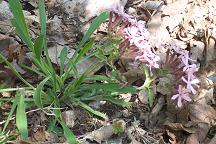
Wild Pink or Catchfly
:
There are several varieties. Silene caroliniana shown here
is pink. S. virginiaca is red. Its sticky stem gives rise to
the name Catchfly.
Spring Beauties (Claytonia virginica): Almost the first flower of spring. Found in
shady trail-side areas. These were encountered on Jeremy's
Run Trail on the last weekend of March.
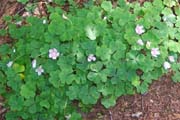
Mountain Wood Sorrel -
Oxalis montana:
Grows in moist, shady forests, usually at higher elevations.
Location: Rohrbaugh Plains Trail, Dolly Sods, MNF, WV.
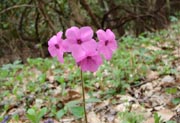
Smooth
Phlox (Phlox
glaberrima): Similar to Garden Phlox but blooms in
May. Location: Allegheny Tr, WV. Photo by Pat Roberts.
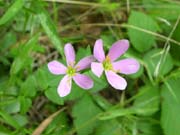
Rose-pink/Bitterbloom
(Sabatia angularis) : Moist fields and roadsides.
Location: Long Pond Trail, GRSF, MD. Photo by Ken Clark.
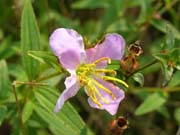
Maryland
Meadow Beauty (Rhexia mariana) - Found in sandy
swamps from Massachusetts south to Fla. Location: Cape
Henlopen, DE. Photo by Ken Clark.
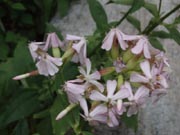
Bouncing Bet or Soapwort (Saponaria officinalis):
Tall plant with clusters of white to light pink
Phlox-like flower clusters. The petals are bent back
upon the flower. Found in sunny waste places, fields and
roadsides. Location: Pocosin Hollow Trailhead on Rt664,
SNP, VA.
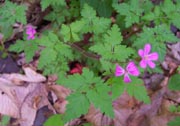
Herb
Robert (Geranium robertianum)
- Small, paired, delightful flower with darker lines on the
petals. Blooms May to October. Location: Jeremy's Run Tr,
SNP, VA.
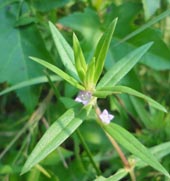
Buttonweed
(Diodia teres) This flower is only 1/8 inch from tip
to tip. Narrow, lancelet leaves. All flowers are in leaf
axils. Invasive to lawns.
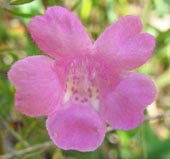
Sandplain
Gerardia (Agalinis acuta): Plant grows up to 8 inches. Found
only in sandy, acidic areas of Rhode Island, Cape May, Long
Island and Maryland. Location: Soldier's Delight, MD. Photo
by Dimitri Tundra.
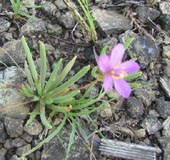
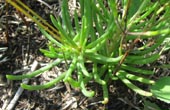
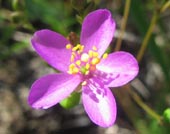
Fameflower
(Talinum teretifolium): Note the thin
succulent-looking basal leaves. Found in rocks and sand.
Photo by Dimitri Tundra.
|
More Simple Flowers
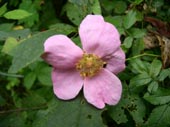
Purple-flowering Raspberry (Rubus odoratus):
Rose-like flowers and large maple shaped leaves. Photo by
Dimitri Tundra.
Legumes
Vetches/Peas/Beans
Bush-clovers
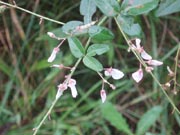
Bush-clover
(Lespedeza violacea): Tall upright, much branched.
Small pink to purple pea-like folwers. Location: Morgan Run
N.E.A.
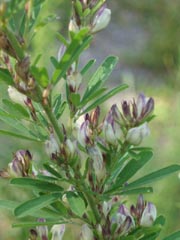
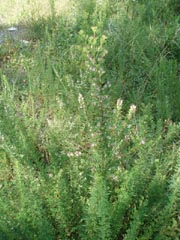
Slender-bush-Clover (Lespedeza virginica): Erect bush
with crowded leaflets in sets of three. Flowers pink to
purple. Open areas. Location: Andy Layne Trailhead, VA.
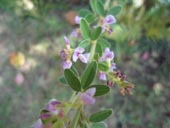
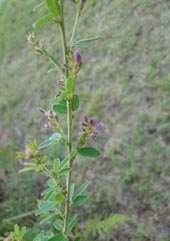
Wandlike Bush-clover (Lespedenza intermedia):
Similar to Slender Bush-clover (above) but the plant has
a single stalk and the leaves, although still ovate, are
not nearly as narrow.
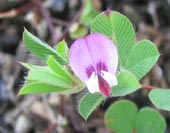
Stueve's Bush-clover
(Lespedeza
stueve1): Very hairy trifolate, oval to eliptical
leaves on short stems sets this one off from the others.
Photo by Dimitri Tundra.
Tick-trefoils
The
flowers of all species are nearly the same. Leaves vary
from species to species.
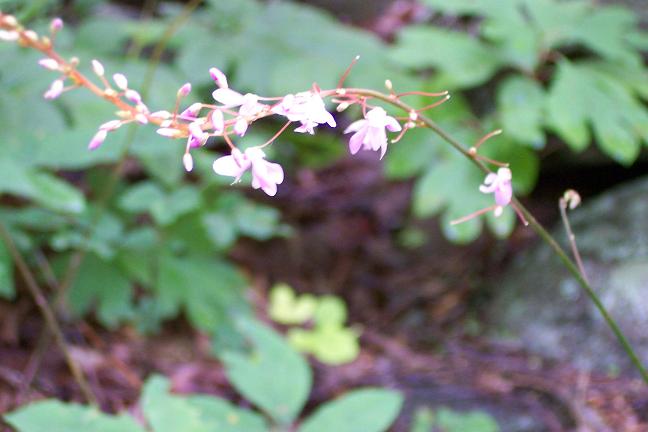
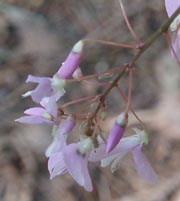
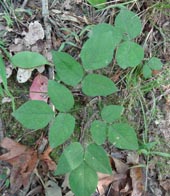
Naked-Flowered Tick- Trefoil (Desmodium
nudiflorum)
:
Grows in rich woods. Blooms in July. This plant has a leaf
stalk and a seperate flower stalk. The two are joined
together underground giving the appearance of a flower with
no leaves. Location: Downs Park, MD.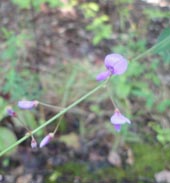
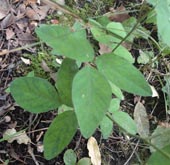
Hoary
Tick-trefoil (D. Canescens).The flowers of all
Tick-seeds are nearly identical. One key difference between
all of them are their leaves. In this family member the
leaves are large, broad and hairy, Location: Downs Park, MD.
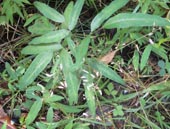
Panicled
Tick-trefoil (D. paniculatum). The flowers in this
photo are mostly spent after exposure to a long period of
rain. Note the long, narrow leaves with long leaflet stems.
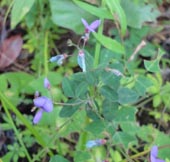
Small-leaved Tick-trefoil (D. marilandicum): The
leaves on this Tick-trefoil are very small, reminiscent of
clover.
|
More Tick-trefoils
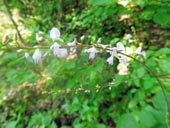
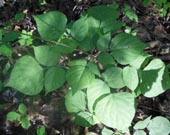
Pointed-leaved or Cluster-leaved Tick Trefoil (Desmodium
glutinosum): Similar to the Naked Tick Trefoil
except this plant has a cluster of large leaves below the
flower stalk. Photo by Dave Bennick.
More Legumes
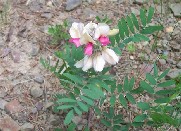
Goat's
Rue or Devil's Shoestrings (Tephrosia virginiana).
The roots used to be feed to goats to increase milk
production until it was found to contain rotenone, an
insecticide and fish poison. Location: Green Ridge State
Forest, MD.
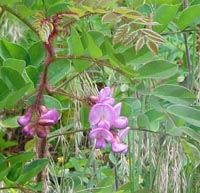
Bristly
Locust (Robinia hispida): Also cultivated. Flowers
similar to Everlasting Pea. Tree/shrub growing upright to 9
feet. Stiff hairs on trunk and stems. Photo by Anita
Mueller. I've seen thousands of these on Gunter Ridge in the
James Rive Face Wilderness Area on VA. They seemed to be
taking over a large burned area.
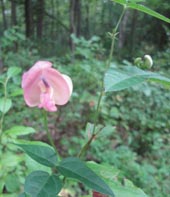
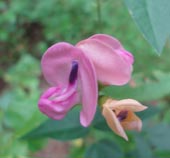
Pink Wild
(Fuzzy) Bean: (Strophostyles umbellatum): Twiny
habit, growing up other plants for support. Lanceolet
leaflets in threes. Flower dime to nickle sized. Hot pink
flower turns peach colored aafter it has been pollinated.
(See bottom photo.) Location Downs Park, MD.
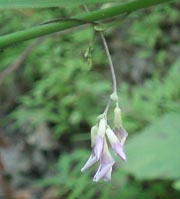
Hog-peanut (Amphicarpa bracteata): Twining vine
with pointed leaves in sets of 3s and drooping clusters
of peak-like lilac flowers in the leaf axils. Location:
Quehanna Wild Area, PA.
Round Terminal Clusters
Japanese Spirea (Spirea japonica):
Considered invasive. These were found growing along the Gun
Powder River. MD above Pretty Boy Reservoir. They were at
their peak in June.
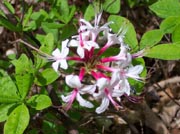
Pinxter Flower/ Wild Azalea (Rhododendron nudiflorum):
Blooms May-June. Latin name refers to the fact that it often
blooms before setting leaves. Location: AT/James River Face.
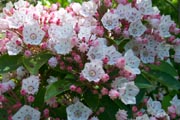
Mountain Laurel (Kalmia latifolia): Pink
or white. These can be found almost anywhere in the
region. These are on Mill Mountain Trail, GWNF, VA on
the way to Big Schloss. Bloom in June.
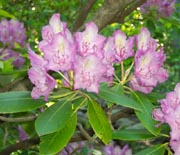
Catawba Rhododendron or Mountain Rosebay (Rhododendron
catawbiense): Evergreen Shrub with large oval leaves
and Rose to deep purple funnel -shaped flowers. Blooms in
May. Northern limits is the southern SNP. Location: Belfast
Tr, James River Face, Glenwood RD, JNF, VA.
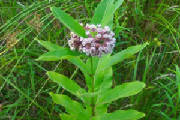
Common
Milweed (Asclepias syriaca): Disturbed, moist,
sunny areas. Butterflies love them! Location: Lake Sherwood
Dam, MNF, WV.
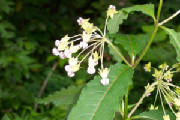
Poke Milkweed (Asclepias
exaltata)
: Grows over 4 feet in height. Grows in wet but
sunny areas. Location: Old Rag Fire Road, SNP, VA.
|
More Round Terminal
Clusters
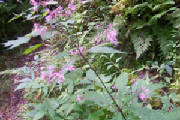
Spotted Joe-Pye-Weed
(Eupatorium maculatum):
Deep pink clusters of flowers supported on dark red stems.
Note the whorls of 5 leaves. Location: All along Tea Creek
and its Right Fork, MNF, WV.
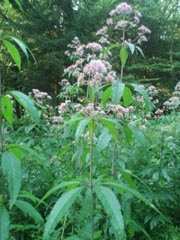
Hollow Joe-Pye-Weed
(E. fistulosum): Similar to above but with whorls of
6 (not 5) leaves. Stem is hollow. Location: Quehanna Wild
Area, PA.
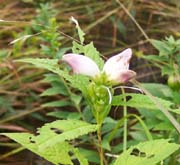
Pink
(Lyon's) Turtlehead (Chelone lyons): In the
Snapdragon family. Grows in high elevations along edges in
Spruce/Fir forests. Location" Hidden Passage, MNF, WV.
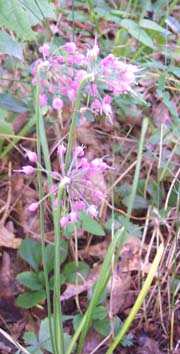
Nodding Wild Onion (Allium cernuum), in the
Lily family. Grows in open woods. Pink to purple,
occasionally white. Blooms August - September. Location:
Shenandoah Mt Trail, Ramsey's Draft Wilderness, GWNF, VA.
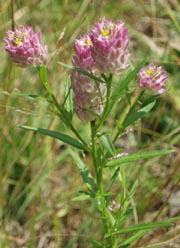
Field
Milkwort (Polygala sanguinea): Alternating leaves.
Found in fields and mesadows. Location: Quehanna Wild Area,
PA.
Long Terminal
Clusters
Smartweeds
At first
glance the casual observer might find it difficult to
distinguish between the different species of Polygonum. In
fact, each species has at least one, and often times other,
characteristics unique to it.
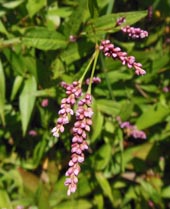
Long-bristled
Smartweed (Polygonum cespitosum). This
species has long bristles along the stem
where the leaf "sheath" is attached. Photo by Dave
Bennick.
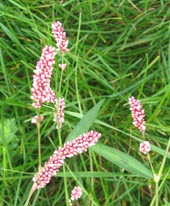
Lady's Thumb
or Redleg (Polygonum persicaria): Similar to P.
cespitosum accept the leaf nodes have very short
bristles. Stems tinged red. Photo by Dave Bennick.
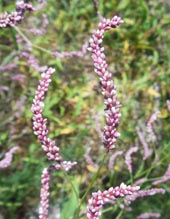
Pale Smartweed
(Polygonum lapathifolium): Flower spikes longer than
the previous species and bent at the upper end. Leaf sheath
absent. Photo by Dave Bennick.
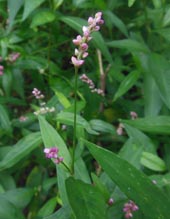
Mild
Water-Pepper (Polygonum hydropiperoides): Flower
spikes sparse and interupted. Found in or near water. Photo
by Dave Bennick.
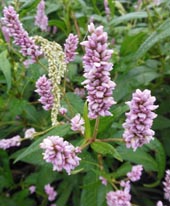
Arrow-leaved
Smartweed (Polygonum sagittatum): Shorter flower
clusters than other smartweeds. Long, arrow shaped leaves.
Photo by Dave Bennick.
.
|
More
Long Terminal Clusters
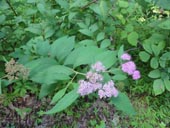
Japanese
Spiraea (Spireaea japonica) A pink flowered escapee.
Location: Glatfelter Area of Michaux S.F., PA.
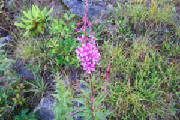
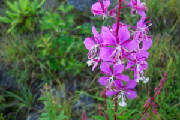
Fireweed (Epilobium angustifolium): Gets its name
from its ability to quickly colonize recently burned
areas. Reproduces via underground runners forming huge
thickets. The deep fuchsia petals with deeper colored,
thinner petals in between, the red stems and often red
tinge in the leaves only add to the name. The red tinge
is not always present. Location: Cranberry Overlook on
Highland Scenic Highway, MNF, WV.
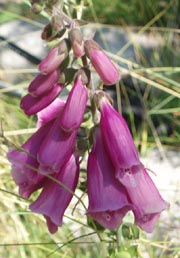
Common
(purple) Foxglove (Digitalis purpuraea): A biennial
introduced from Europe and Asia. The extract is used to make
cardiac medicines. The entire plant is extremely toxic. A
rosette of broad lancelet leaves form the first year
followed by the flower stalk the next year. Blooms late
spring to early summer. Location: Sugarloaf Mt, MD.
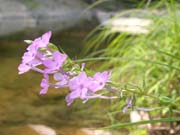
Wild Sweet
William or Meadow Phlox (Phlox maculata): Found along
the banks of Fifteen Mile Creek, GRSF, MD. Photo by Ken
Clark.

Dense
Blazing-Star (Liatris spicata): Dense wand of
Thistle-like blossoms w/grasslike leaves. Photo by Dimitri
Tundra.

Purple
Loostrife (Lythrum salicaria): An escaped ornamental
capable of quickly covering vast wetland areas. Photo by
Dimitri Tundra.
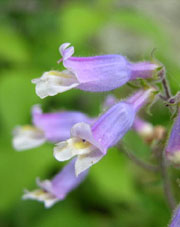
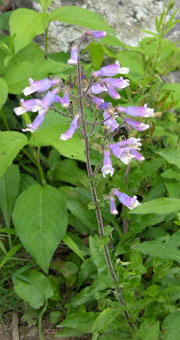
Hairy
Beardtongue (Penstemon hirsutis) Pink to violet/blue
flowers atop woolly stems. Note the white lips. Gray
Beardtongue will have blue veins here. Blooms June to
July on dry, rocky ground. Photos by Ken Clark. Location:
Great Falls National Park, MD, Billy Goat Trail
More
Pink Flowers
 |

